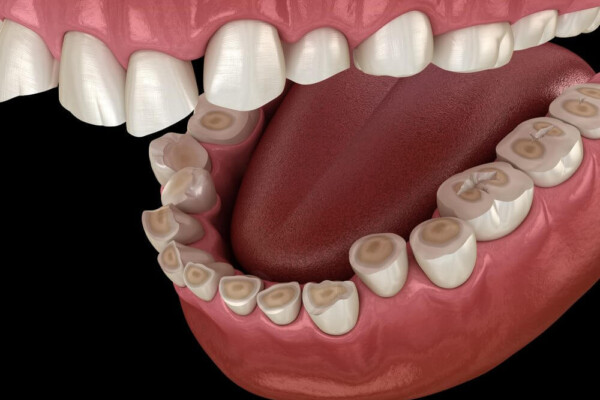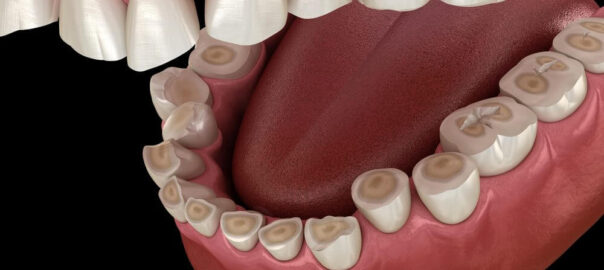Dental erosion arises when, for some reason, there is a weakening of the dental enamel due to the impact of certain chemical agents that are generated depending on the lifestyle of each person.
When these agents are not solved in time, they tend to cause a variation in the pH of the saliva, leaving the dental composition unprotected and giving rise to its deterioration, triggering sequelae not only aesthetically, but also functionally and dental.
If you want to know more about dental erosion, what factors trigger its origin or how it can be solved… Keep reading!
Types Of Dental Erosion
There are 2 types of dental erosions, which can appear simultaneously in people:
Intrinsic dental erosion
This typology originates due to an origin of the organism, being more recurrent in those people who present stomach problems, suffer from a sensation of acidity, psychological or eating disorders.
Extrinsic dental erosion
In this case, it usually originates due to an excessive intake of medications or food on a daily basis, as is the case of those that contain a high content of hydrochloric acid.
What Symptoms Does Dental Erosion Produce?
There are various factors that help trigger enamel deterioration, as well as the origin of this pathology, completely harming oral health, among them, it is worth noting:
Tooth discoloration
The hue may become slightly more yellowish due to damage to the enamel.
In this aspect, it harmfully affects the dentin or the layer responsible for providing color to them.
Tooth sensitivity
By leaving the dentin fully exposed, it will cause the teeth to suffer from extreme sensitivity.
This will cause the dental pieces to become more sensitive in the presence of certain harmful agents.
This sudden sensation tends to increase in a profound and defined way after the ingestion of certain foods with high or low temperatures, or highly sucrose foods.
Smaller teeth
By decreasing the enamel, the dental pieces will show a much more rounded shape that will forge a vision of smaller or dwarfed pieces.
Cracks or crevices
People who suffer from erosions can perceive how the dental edges will lose their hue, becoming more crystalline or showing small cracks and crevices on the masticatory surface.
What Problems Does Dental Erosion Cause?
Dental erosion usually affects aesthetically, however, over time, it can be accentuated and cause the pieces to become much more brittle and irascible.
In its earliest or initial stages, it will not be possible to diagnose it with certainty, since its symptoms do not usually present constant signs or discomfort, quite the opposite.
But, when it comes to much more advanced stages of the pathology or in a critical state, the damage to the enamel will become irreversible and more evident, triggering the following consequences:
- Insightful annoyances due to sensitivity.
- Dark tonality or whitish shades that darken over time.
- Very pronounced cracks or fissures.
- Teeth lacking in their superficial areas.
- Tooth sensitivity.
Treatments For Dental Erosion
The treatments specialized in solving the negative effects that this condition entails tend to vary depending on the level of severity that it presents.
However, the dentist will have to identify the exact origin of the erosion in order to plan the respective treatment in a personalized way.
When diagnosing the triggering origin, the type of treatment will be established taking into account the degree of progress in which the condition is found. Thus, three forms can be distinguished:
Grade I dental erosion
In the initial stages, it will be enough to follow some preventive guidelines proposed by the dentist.
These will help the condition to calm down without generating future sequelae that trigger greater severity for dental health.
Grade II dental erosion
This type of wear involves the loss of enamel in a specific area, fully exposing the dentin.
In this case, it is essential to invigorate the affected piece through a filling or after the placement of aesthetic veneers.
Grade III dental erosion
When the stage becomes severe or critical, it will affect various areas of the tooth, damaging its adjacent or underlying parts.
Therefore, it is advisable to submit the patient to a recomposition, endodontics, incrustations or placement of crowns.
How To Prevent Dental Erosion?
Erosion can be prevented by following some tips:
- Reduce acidic foods or drinks with a high level of sucrose.
- Maintain strict oral cleaning. In this way, it will be possible to eradicate food debris that tends to accumulate between the teeth.
- Brush with toothpaste that contains a high level of fluoride, and at least 2-3 times a day. In addition, you must complement daily brushing with the use of dental utensils such as dental floss or oral irrigators, among others.
- Hydrate constantly.
- Attend consultations or appointments scheduled with the dentist.
- Do not exert too much force in your daily brushing, since aggressive brushing can damage tooth enamel.



